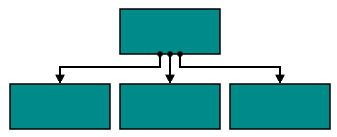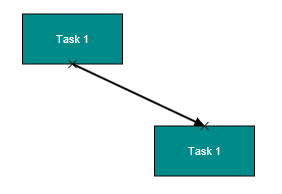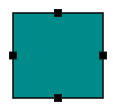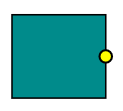Ports in ASP.NET Web Forms Diagram Control
16 Sep 20247 minutes to read
Essential Diagram for ASP.NET provides support to define custom ports for making connections.

When a connector is connected between two nodes, its end points are automatically docked to node’s nearest boundary as shown in the following image.

Ports act as the connection points of node and allows to create connections with only those specific points as shown in the following image.

Create Port
Add ports when initializing nodes
To add a connection port, you need to define the port object and add it to node’s Ports collection. The Offset property of port accepts an object of fractions and used to determine the position of ports. The following code illustrates how to add ports when initializing the node.
<%-- To Create a port --%>
<ej:Diagram ID="Diagram" runat="server" Height="400px" Width="400px">
<Nodes>
<ej:BasicShape Name="node1" OffsetX="100" OffsetY="100" BorderColor="black" BorderWidth="2" FillColor="darkcyan">
<%-- Adding the ports to the ports collection --%>
<Ports>
<ej:DiagramPort Name="port1" Visibility="Visible">
<%-- Specifies the offset of the port --%>
<ej:Offset X="0" Y=".5"></ej:Offset>
</ej:DiagramPort>
</Ports>
</ej:BasicShape>
</Nodes>
</ej:Diagram>Add ports at runtime
You can add ports at runtime by using the client side method addPorts. The following code illustrates how to add ports to node at runtime.
// Defines a collection of ports that have to be added at runtime
var ports = [
{
name: "port1",
// Specifies the port offset – fraction value relative
to node bounds – determines the position of port on node
offset: {
x: 0,
y: 0.5
}
},
{ name: "port2",offset: {x: 1,y: 0.5 }},
{ name: "port3",offset: {x: 0.5,y: 0 }},
{ name: "port4",offset: {x: 0.5,y: 1 }}
];
// Gets the instance for the Diagram
var diagram = $("#diagram").ejDiagram("instance");
// Adds the ports to the node of name "node"
diagram.addPorts("node", ports)
To explore the set of properties for defining a port, refer to Port Properties
Update Port at runtime
The client side API updatePort is used to update the ports at run time. The following code example illustrates how to change the port properties.
var diagram = $("#diagram").ejDiagram("instance");
var selectedObject = diagram.model.selectedItems.children[0];
var visibility = ej.datavisualization.Diagram.PortVisibility.Visible;
diagram.updatePort(selectedObject.name, selectedObject.ports[0], { fillColor: "red", visibility: visibility });Connect with ports
Connector’s SourcePort and TargetPort properties allow to create connections between some specific points of source/target nodes.
For more information about creating connections with port, refer to Connections with ports
Appearance
You can change the shape of port by using its Shape property. To explore the different types of port shapes, refer to Port Shapes.
The appearance of ports can be customized with a set of style specific properties.
The following code illustrates how to change the appearance of port.
<ej:Diagram ID="Diagram" runat="server" Height="400px" Width="400px">
<Nodes>
<ej:BasicShape Name="node1" OffsetX="100" OffsetY="100" BorderColor="black" BorderWidth="2" FillColor="darkcyan">
<%-- Adding the ports to the ports collection --%>
<ports>
<%--Customizes the appearance and Defines the shape of port--%>
<ej:DiagramPort Name="port1" Visibility="Visible" Shape="Circle" FillColor="yellow" Size="12" BorderColor="black" BorderWidth="2">
<%-- Specifies the port position --%>
<ej:Offset X="1" Y=".5"></ej:Offset>
</ej:DiagramPort>
</ports>
</ej:BasicShape>
</Nodes>
</ej:Diagram>
Constraints
The Constraints property allows to enable/disable certain behaviors of ports. For more information about port constraints, refer to Port Constraints